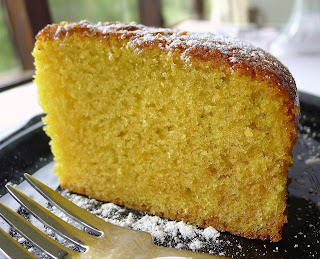Do you try to read the titles on the bookshelves behind the talking heads on TV? During lockdown, newscasters, doctors, scientists, historians, actors, authors, now come to you from their homes, usually with a backdrop of bookshelves.
 |
| Over my shoulder: My home office is a corner of the bedroom. Here are shelved Spanish cookbooks, guidebooks and histories that I use as reference in my writing. |
My rule is to discard cookbooks that I never cook from. But, on the highest shelf in the kitchen, totally out-of-reach, are some “classics” that I can’t bear to dispose of, even if I never use them anymore. In that category are Japanese Cooking: A Simple Art, by Shizuo Tsuji; Diana Kennedy’s My Mexico; Great Italian Cooking, by Luigi Carnacina (I cooked my way through this tome back in the late 1960s); The Joy of Cooking; The Spice Cookbook by Avanelle Day and Lillian Stuckey (seven recipes for potato salad!); two volumes of Julia Child.
 |
| The most used books--global cuisines. |
Closer to hand are old favorites, books I use regularly. They once provided me with an introduction to cuisines of many countries—Madhur Jaffrey’s Indian Cookery, Paula Wolfert’s Moroccan Cuisine; George Moudiotis’s Traditional Greek Cooking; The Original Thai Cookbook, by Jennifer Brennan; Good Food from Mexico by Ruth Watt Mulvey and Luisa Maria Alvarez; Pleasures of the Vietnamese Table by Mai Pham, and A Book of Middle Eastern Food by Claudia Roden. Now, I tend to open to a single recipe that has become a favorite over the years.
This long period of lockdown has been a great opportunity to delve into more of my cookbook collection.
Here’s a recipe from The Philippine Cookbook by Reynaldo Alejandro (Perigee Books, 1985). The book was given to me by my Filipina sister-in-law, Rosa Gereña Mendel. Leafing through it, I am amazed to find, along with exotic Asian ingredients, many Spanish dishes—adobos, estofados, even paella!
Not so surprising when I am reminded that, in 1521, Ferdinand Magellan explored the Philippines for the Spanish crown. They were named las islas filipinas, in honor of King Philip II. The Spanish colonial influence lasted until 1898 and had a lasting and monumental effect on the Philippines.
 |
| Chicken pieces cook in a rich savory sauce of soy and vinegar with garlic and pepper. A similar process to Spanish adobo, but with different flavorings. |
 |
| Serve Filipino adobo with white rice. |
Chicken Adobo (Adobong Manok Sa Gata)
Pollo Adobado Estilo Filipino
Pollo Adobado Estilo Filipino
I love the simplicity of this recipe. It requires little prepping, no browning of chicken or sauteeing as for a sofrito. All the ingredients simmer together, creating a dish of tender chicken and flavorful sauce.
If the amounts of soy sauce and vinegar seem excessive, be assured that they mellow in cooking, finishing with a subtle sweetness. While you probably won’t need additional salt, neither will the chicken taste too salty. The whole peppercorns are a matter of taste. I find them thrilling, like chile. But, if biting into a whole peppercorn is not to your taste, use ground black pepper instead.
If the amounts of soy sauce and vinegar seem excessive, be assured that they mellow in cooking, finishing with a subtle sweetness. While you probably won’t need additional salt, neither will the chicken taste too salty. The whole peppercorns are a matter of taste. I find them thrilling, like chile. But, if biting into a whole peppercorn is not to your taste, use ground black pepper instead.
My Filipina sister-in-law, Rosa, uses coconut vinegar for her adobo. The recipe in this cookbook calls for apple cider vinegar. I used white wine vinegar. Rosa, who lives in the Los Angeles area, is from the Visayas region of the Philippines. She says she has modified her traditional recipe to use less salt, sugar and fat.
I love foods with coconut milk, so I chose to make the enhanced version in the cookbook.
(Recipe adapted from The Philippine Cookbook by Reynaldo Alejandro.)
(Recipe adapted from The Philippine Cookbook by Reynaldo Alejandro.)
Serves 4.
2 ½ pounds chicken legs and thighs
½ cup soy sauce
2/3 cup white vinegar
12 cloves garlic, peeled and crushed
2 bay leaves
½ tablespoon peppercorns
½ cup coconut milk (optional)
Sliced green or red chilies (optional)
Steamed rice to serve
½ cup soy sauce
2/3 cup white vinegar
12 cloves garlic, peeled and crushed
2 bay leaves
½ tablespoon peppercorns
½ cup coconut milk (optional)
Sliced green or red chilies (optional)
Steamed rice to serve
 |
| Marinate chicken before cooking. |
Combine the chicken pieces, soy, vinegar, garlic, bay and peppercorns in a deep pan. Marinate 2 hours.
Place on high heat and bring to a boil. Reduce heat to medium and cook the chicken 20 minutes. Turn the chicken pieces and cook 15 minutes longer or until chicken is tender.
Preheat broiler.
With tongs, remove the pieces of chicken. Place them on a sheet pan or rack. Place the rack under the broiler until chicken is browned and lightly glazed, 10 minutes.
 |
| Broil chicken to brown the skin. |
Add the coconut milk, if using, to the remaining sauce in the pan. Raise the heat and boil until the sauce is reduced by half.
 |
| Return broiled chicken to the adobo sauce. |
Cover the broiled chicken pieces with the sauce. Garnish with sliced chilies, if desired. Serve hot accompanied by rice.
Some Spanish adobo recipes:



































